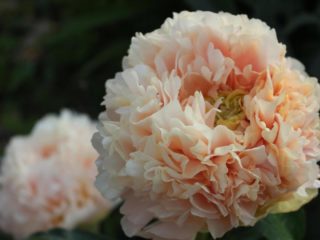Content
Iberis is planted along the edges of lawns, in rocky and standard flower beds. Its delicate flowers often become part of wedding bouquets. Fortunately, growing Iberis from seeds is not difficult. Even a little experience in gardening will help you cope with its reproduction on your personal plot.
Features of growing Iberis from seeds
Although Iberis can be propagated by cuttings, a more popular method is by growing from seeds. They give good germination. The sprouts are strong and resistant to external influences. Seed propagation of plants is carried out in two ways:
- sowing in open ground;
- growing seedlings.

Iberis serves as an excellent decor for a house, plot, flower bed, lawn and alpine hill
When and how to sow Iberis directly into the ground
The right time to plant seeds in open ground is selected taking into account the region. Iberis does not withstand severe frosts, so only residents of areas with warm winters can afford to plant in the fall. In most cases, seeds are planted in open ground in mid-April. In order for flowering to continue continuously until the end of September, sowing in one place is carried out in two or three passes. Before the second and third stages, they wait 2-3 weeks.
Seeds are sown sparsely on the surface of the soil. Sprinkle a thin layer of earth on top and carefully water it. Two weeks after germination, the seedlings are thinned out, leaving 15 cm between adjacent plants.
Growing Iberis seedlings
If you plant Iberis seedlings correctly and provide them with high-quality care in the future, the plants will be stronger and begin to bloom earlier. To do this, it is important to select suitable containers and substrate, as well as follow recommendations regarding light, watering and fertilizing. The sprouts need to be thinned out in time and then properly planted in open ground.
When to plant Iberis seedlings
Planting seeds for seedlings in a greenhouse or at home is carried out in early March. To ensure continuous flowering throughout the summer, the same principle is used as in open ground - sowing in stages.
Approximate diagram:
- March 1-5;
- March 15-20;
- March 30 - April 5.
Transferring seedlings to open ground is also carried out in three stages. The sprouts obtained from the second and third passes are placed in the spaces between the first. The result is a flowerbed of continuous flowering.
Preparing containers and soil
Iberis is sowed for seedlings in shallow but wide boxes, which will not complicate further care.They must have drainage holes, as the plant does not tolerate stagnant moisture. You need to think in advance where to place containers with seedlings, because you will need a lot of light.
Iberia is not picky about soil, so the most common substrate for growing seedlings or flowers is suitable. Another option is to mix garden soil with peat and sand. The result should be a light and loose mixture.
How to plant Iberis
Planting Iberis seeds for seedlings is extremely simple. To do this, you need to take only 4 steps:
- Distribute the seeds over the surface of the substrate at intervals of about 2 cm.
- Sprinkle with a 1 mm thick layer of river sand.
- Thoroughly moisten the soil with a spray bottle.
- Cover with clear film or glass.
Shelter helps retain moisture and heat necessary for seed germination. After planting, the film or glass is periodically removed for ventilation. The soil should always be moist.
How to grow Iberis seedlings
Iberis is an extremely unpretentious plant, even at the seedling stage. After germination, the box is placed in a bright place. If there is not enough sunlight, artificial lighting is used. Experienced flower growers advise to be careful when watering young shoots: dry soil inhibits their development, and waterlogging can lead to rotting of the roots.

Iberis seedlings are grown without picking, as the roots do not tolerate transplantation well.
When two true leaves appear on each sprout, you need to pay attention to the planting density. There should be a gap of 2-3 cm between neighboring plants; the excess ones are removed.This will be enough for the normal development of the root system. Picking for Iberis is extremely undesirable.
Two or three weeks before planting on the site, young shoots are hardened off. To do this, the box is placed outside. The duration of daily hardening is gradually increased. Immediately before planting, the seedlings are kept in the fresh air around the clock.
Planting and caring for perennial Iberis in the ground
Anyone who has seen the charming Iberis flowers in the photo involuntarily considers the process of planting and caring for the plant to be extremely difficult. However, as you can see, growing seedlings is quite simple. Moving sprouts into open ground and further agrotechnical measures are also not very labor-intensive.
Recommended timing
Iberis is not frost-resistant, so the date of planting seedlings must be carefully considered. At the time of the event, the risk of return frosts should be completely absent. This period will differ in different regions. In the middle zone it usually falls at the end of May.
Site selection and preparation
A flowerbed with Iberis is always located in a sunny place. In the shade, the plant looks weakened, its stems stretch, the leaves become thinner, and there are significantly fewer flowers. Such a bush is not capable of becoming a decoration for the site.
The soil for the plant is not of key importance, so there is no need to specially prepare the site. Before planting, the soil needs to be dug up. If the soil is heavy or depleted, organic fertilizers are added to it.
Landing rules
Iberis seedlings grown from seeds are planted as follows:
- Water the substrate generously.
- Dig out the sprouts along with the soil near the roots.
- Make holes in the ground at a distance of 15 cm from each other.
- Place the sprouts in them and sprinkle with soil.
- Water each plant generously.
Watering and fertilizing schedule
Iberis calmly tolerates short periods of drought. However, a prolonged lack of moisture sharply reduces the decorative value of the bushes. Therefore, during dry periods, at least one heavy watering per week is necessary.
Feeding for Iberis is not necessary. They should only be used on poor soils. It is enough to apply a solution of complex mineral fertilizer at the root of each bush 1 or 2 times during the summer. This will help increase the number of buds.

For lush flowering, the plant is fed several times a year.
Trimming
All Iberis buds at the wilting stage must be cut off immediately. This is necessary to achieve the following goals:
- prevention of self-seeding;
- stimulation of the formation of new buds;
- maintaining the aesthetics of the bush.
Pre-winter pruning of perennial varieties is carried out in the fall, after removing the last faded bud. Cut off a third of each branch. This reduces the risk of frostbite.
Wintering
The plant can withstand warm winters without shelter. Under the influence of severe frosts in the absence of thick snow cover, the bushes are at risk of frostbite. This will not necessarily lead to the death of the plant, but will significantly weaken its strength. To prevent sad consequences, Iberis bushes after pruning are covered with spruce branches, dry leaves or non-woven material.
Diseases and pests
Most often, the plant is affected by fungal diseases such as powdery mildew and fusarium. The defeat results from waterlogging of the soil.
To prevent the problem, take the following measures:
- Treat the soil with fungicides before planting.
- Plants are sprayed with special preparations during the dry period.
- They increase soil looseness and improve drainage.
- Affected plants are immediately removed from the site.
- Moderate watering is carried out.
- During periods of heavy rainfall, the soil is constantly loosened.
Iberis is often attacked by flea beetles, leaving round holes on the leaves. The fight against it comes down to regularly moistening the soil. Cabbage aphids are a problem for all cruciferous plants; they disappear after using a soap solution. But mealybugs can only be removed with insecticides. Moreover, one-time treatment does not always work.

Signs of the presence of flea beetles on Iberis are numerous holes on the leaves
Need for transplant
A permanent place for Iberis should be selected for 5 years. The tap root of the plant does not like transplantation at all, so it is often not recommended to transfer it to a new site. But after 5 years of life, Iberis blooms reluctantly and its overall decorative effect decreases sharply. To prevent this, the bush is dug up and divided, and the “divisions” are planted in a new place.
How to collect Iberis seeds
To collect seeds, the largest flowers are left on the bushes. To avoid self-seeding, you need to put gauze bags on them. After the buds have dried, they are cut and laid out in a dry, ventilated room to dry thoroughly. Then the seeds are separated from the petals and placed in paper envelopes. Storage requires a dark room with dry and cool air.
Conclusion
Growing Iberis from seed is rewarding work.In return for the minimum effort of the grower, the crop pleases with lush flowering throughout the summer. Delicate buds of white, pink or purple colors perfectly complement various flower beds. When cut, they can be used to create charming bouquets.








